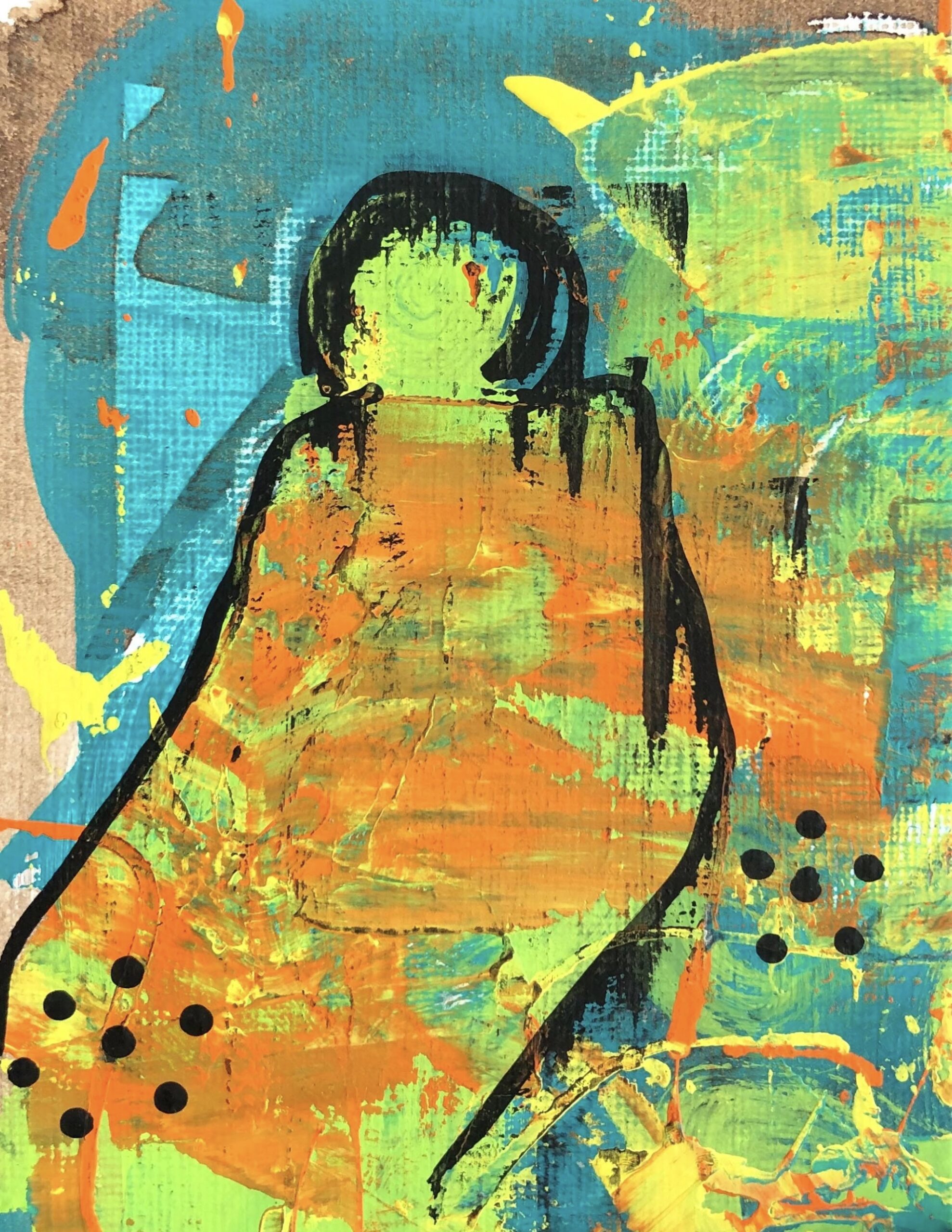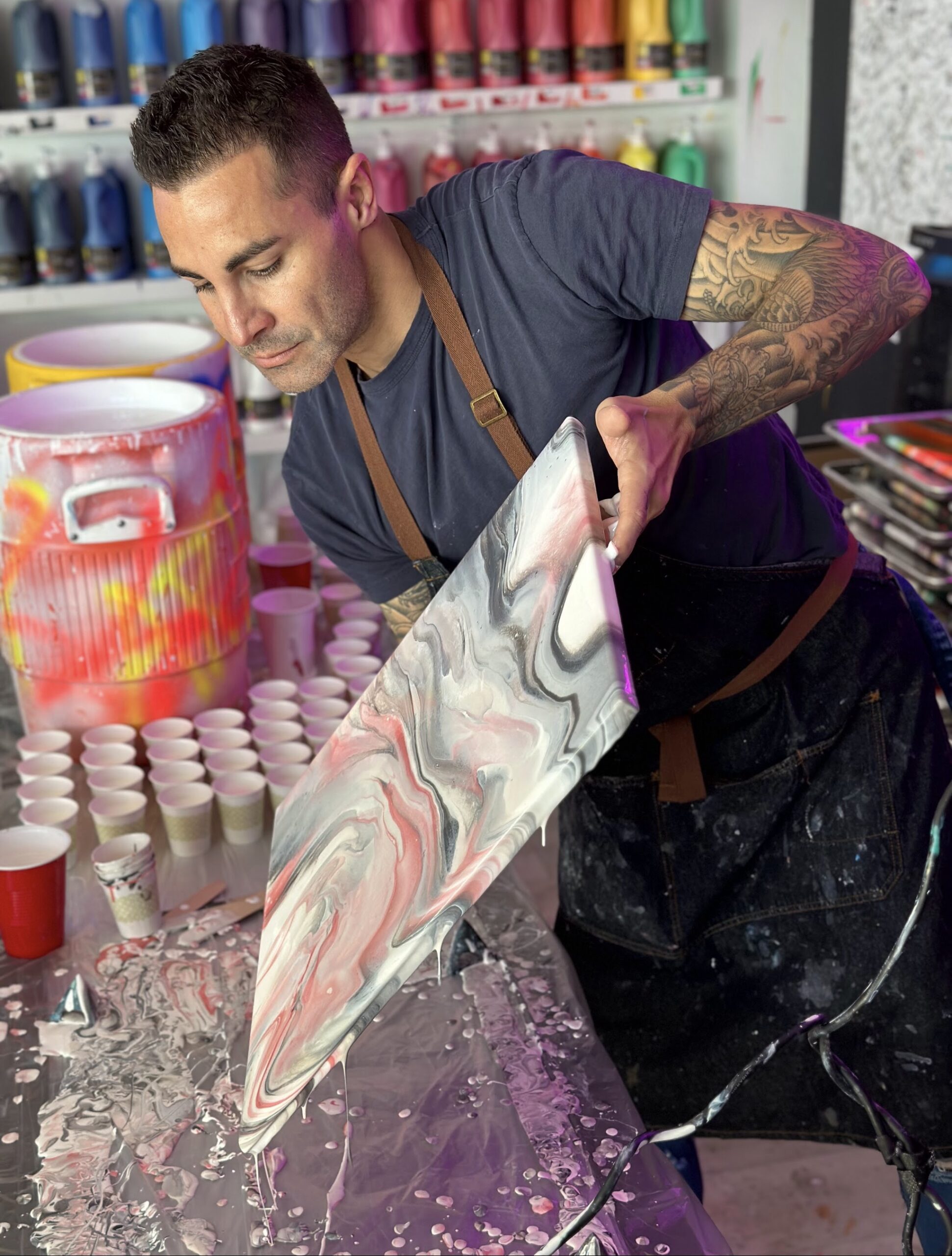Improving emotional well-being through everyday creativity
By Rebecca L. Rhoades
Phoenix-based journalist Jackie Dishner has always been a creative person. As a respected journalist, she has authored numerous magazine articles and books. She collaborated on a public art project with a local photographer about bicycling — she wrote poetry, he provided images. And in between her work, she would flirt with landscape painting. She even sold a few of her works.
Then came the 2020 pandemic. Both Dishner and her husband came down with severe cases of COVID-19. The heated conflict of presidential elections later that year added to her stress and anxiety. To cope, she began to focus on her artistic passions.
 “When Covid hit, I set writing aside and painted my way through the lockdown and beyond,” she says. “It helped me deal with a lot of emotional stuff that was going on at the time. It calmed me. I felt like me with paints and paper.”
“When Covid hit, I set writing aside and painted my way through the lockdown and beyond,” she says. “It helped me deal with a lot of emotional stuff that was going on at the time. It calmed me. I felt like me with paints and paper.”
Today, Dishner manages a thriving Facebook group, “Creative Coping for Women,” which has almost 500 members from across the country. Participants can share their creative pursuits in a nonjudgmental forum, create themed projects such as holiday greeting cards and collages, and discuss how creativity helps them cope with life’s challenges, big and small.
“The point of the group is to provide a safe place where women can go to reconnect with that childlike mind to play with their innate ability to create and problem-solve, to creatively work their way out of the stressors of the day, to unblock and maybe to find their way back to the creative pursuits they once enjoyed or would like to try,” Dishner explains. “Creative coping isn’t ignoring the problem. It’s about giving yourself a safe space to resolve it or to find a better path than the one you were one.”
Numerous scientific studies point to the beneficial impact creative expression has on our emotional and mental well-being. It has been embraced throughout history as a healing tool in many cultures. Pictures, stories, dances, and chants have been used as healing rituals. And modern-day research has proven that artistic engagement has a significantly positive effect on health, by decreasing anxiety, stress and mood disturbances, and by increasing self-esteem.
More Than Art
“People associate creativity with an action and an output, whether that’s painting or dancing or writing music. But it’s really about problem-solving,” says Carrie Bloomston, a Phoenix-based artist, art teacher, and author of two books on creative living. “Creativity is the ability to find answers to the problems that crop up in your life, whether you are making art or not.”
Bloomston notes that as we age, our days become consumed with the responsibilities and obligations of everyday life — jobs, kids, bills. “As adults, our lives are happening to us,” she explains. “There are only so many hours in a day, and you’re tired. The last thing you want to do is take a belly dancing class or learn to play an instrument.”
 She also points out that creative pursuits often are the first programs to be eliminated when times are tough. For example, art and music classes are the first to be eliminated during school budget cuts, even though studies have proven that students involved in these programs score higher on standardized tests, have a larger vocabulary, and have stronger fine motor skills than students who aren’t. According to the National Association for Music Education, kids who participate in music education are communicative, cooperative, and coordinated.
She also points out that creative pursuits often are the first programs to be eliminated when times are tough. For example, art and music classes are the first to be eliminated during school budget cuts, even though studies have proven that students involved in these programs score higher on standardized tests, have a larger vocabulary, and have stronger fine motor skills than students who aren’t. According to the National Association for Music Education, kids who participate in music education are communicative, cooperative, and coordinated.
“The arts are core to mental and emotional health, social and emotional growth, and overall development,” Bloomston says. “Yet it’s often the thing that people get denied.”
In her latest book, The Big Book of Little Sparks: Creativity Journal, Bloomston offers activities and exercises designed to nurture your inner child and let your imagination flow. From pasting photos into pre-printed frames to coloring in designs, the actions stimulate the imagination without the pressure of developing ideas or demanding perfection.
“People get very attached to succeeding. I refer to this as ‘masterpiece syndrome,’” Bloomston says. “Trust the process and make mistakes. Play, mess around, approach the moment as it’s unfolding around you.”
Victoria Sylos-Labini is a licensed clinical psychologist in Washington, D.C. She incorporates a variety of creative processes, including journaling and music in her treatment therapies.
“We can use creativity to access our subconscious and express ideas, suppressed emotions, or feelings through various forms of art,” she says. “Many forms of creativity are nonverbal, so they can be particularly helpful for people who have difficulty communicating, expressing themselves, or have experienced trauma. They can express themselves in ways that feel safe to them.”
Like Bloomston, Sylos-Labini praises the meditative effects of adult coloring books, which saw an explosion in demand in the mid-2010s.
“Sometimes just scribbling or playing with colored pencils can help you focus,” she says. “You don’t actually have to create something. You can just be present in the moment while you’re doing it. It can help regulate your nervous system.”
Treating Past Trauma
A 2016 study of art therapy for veterans with post-traumatic stress disorder found that art therapy allows patients to experience and verbalize difficult emotions, provides a distraction, and can lead to positive emotions through the creation process.
For Brandon Lee, art is a lifesaver.
Lee has never been one to shy away from his past traumas, including abuse and drug addiction. The former Channel 3 news anchor had been in recovery for about 13 years when, during the pandemic, he relapsed and became suicidal. He began shamanic therapy, and in early 2021, he started having a recurring dream of a little boy with a can of paint.
“I kept getting visions of artwork, and it made no sense to me,” he recalls. “I had dabbled in art, but it never connected.” So he went to the store and got some supplies and started to create as a way to address his past trauma and start healing.
Then, on July 8, he awoke to find three words written on a paper towel next to his bed: studio, gallery, and school. “My shaman said, ‘This is where the journey is about to lead you, and it will be life changing.’” Two days later, a voice told him to leave the news and develop an art studio to help trauma survivors.
In November 2021, Lee opened Art of Our Soul, a hands-on therapeutic painting program that works with recovering addicts, patients with brain injuries, and victims of sex trafficking.
“A lot of times in recovery, people will have a clinical art therapist on staff, and they collage, they do clip art, and they talk about their traumas. While there is a purpose in that, it’s not fun, and it doesn’t release dopamine,” Lee explains. “I wanted to create something that people look forward to in the early stages of their trauma recovery, because when you’re in the early stages, it’s heavy, and it’s really dark at times.”
 According to Lee, his program helps to create new neural pathways in the brain, which allows dopamine to be released naturally. Often called the “happy hormone,” dopamine is a neurotransmitter that provides feelings of pleasure.
According to Lee, his program helps to create new neural pathways in the brain, which allows dopamine to be released naturally. Often called the “happy hormone,” dopamine is a neurotransmitter that provides feelings of pleasure.
“If you’ve been on drugs for a long time, all the joy is gone,” he says. “Life gets black or gray; there’s no color. We have to re-create those neural pathways in order to bring color back into your life.”
Art of Our Soul combines music with the art of acrylic pouring. There are no paintbrushes or preconceived designs to replicate. Patients use their hands to create vividly hued one-of-a-kind abstract artworks on canvas. In the background, a playlist of high-energy EDM music keeps the energy flowing.
“When you’re creating something with your hands, you get lost, and your body gets elevated into what science calls an alpha state,” Lee says. Some people refer to this as being in “Zen,” in the flow, or even a light hypnotic state. “It lowers your heart rate; helps with anxiety, depression and suicidal ideation; and brings joy and peace. And that’s exactly what happens here — at every single session.”
While studies have shown the benefits of art therapy in the treatment of clinical patients, both Sylos-Labini and Dishner say the same thing: You don’t need to have experienced trauma to receive the benefits of creativity.
“Creativity can be helpful for everyone,” Sylos-Labini emphasizes. “You don’t have to have trauma to write a poem or color in a coloring book. Everyone can benefit from emotional healing and an increased sense of well-being.”







